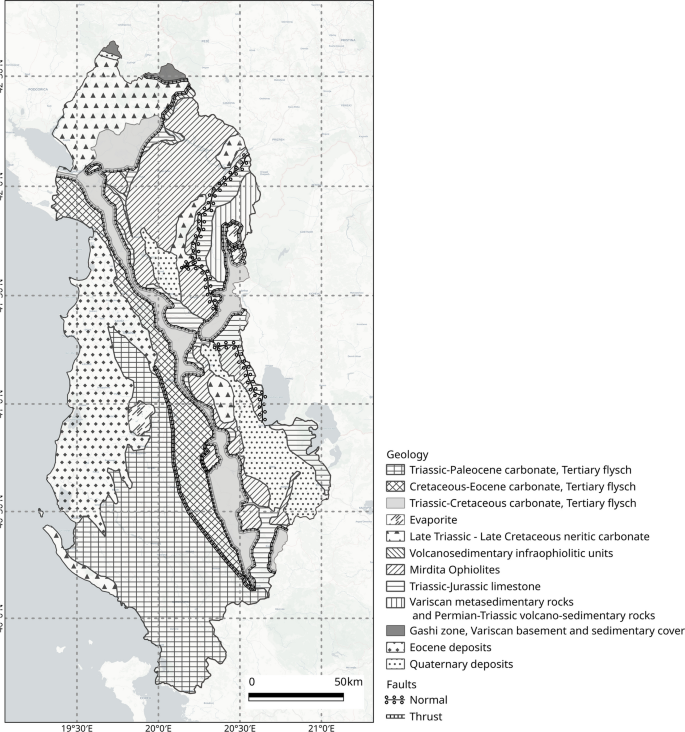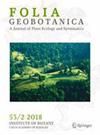阿尔巴尼亚的生物区域划分:植物群和气候之间的不匹配表明我们的南欧生物区域模型需要修订
IF 1.2
4区 生物学
Q3 PLANT SCIENCES
引用次数: 0
摘要
本文采用Barina Z (ed.)(2017)的《阿尔巴尼亚维管植物分布图》(维管植物分布图)中的数据,对阿尔巴尼亚所有维管植物物种在25 km网格上进行分层聚类,分析了阿尔巴尼亚的区系细分。匈牙利自然历史博物馆,布达佩斯)。我们确定了植物区系变化的主轴和解释它的生物气候变量。我们还通过主要气候变量的自组织图(SOM)和Rivas-Martínez全球生物气候模式的应用分析了阿尔巴尼亚的生物气候。我们将基于植物区系的分析与基于生物气候的分析进行了比较。结果将阿尔巴尼亚划分为8个区系单位,分别对应于主要的植被类型(东方松林、黑栎林、栎木和山毛榉林、球柏林、桧林、黑松林、阿尔巴尼亚北部高寒植被和阿尔巴尼亚东部高寒植被)。主要有两个变化趋势:与7月平均气温密切相关的四个高程带和与年降雨量和热偏移弱相关的南北细分。生物气候学分析(SOM和Rivas-Martínez模型)解析并增加了高程带轴线的细节,但不能分辨出除高山外的南北细分。我们根据两个梯度将植物区系划分为八个单位:四个海拔带,每个又细分为中北部和南部省份。这两个梯度在南欧似乎具有更广泛的意义,特别是在纬度30°左右的南北细分。生物气候和植物区系之间的部分不匹配表明,欧洲的生物气候模式需要修订,并表明历史,除了当今的气候(例如,最后一次冰川极大期的植被),可以在塑造南欧的生物地理方面发挥作用。本文章由计算机程序翻译,如有差异,请以英文原文为准。

Bioregionalization of Albania: Mismatch between the flora and the climate suggests that our models of Southern European bioregions are in need of a revision
Abstract We analysed the floristic subdivisions of Albania by hierarchical clustering of all the vascular plant species of Albania over a grid of 25 km cells, adapting data from the Vascular Species Distribution Atlas in Albania of ( Barina Z (ed.) (2017) Distribution atlas of vascular plants in Albania. Hungarian Natural History Museum, Budapest). We identified the principal axes of variation of the flora and the bioclimatic variables that explain it. We also analysed the bioclimate of Albania by means of a self-organizing map (SOM) of the main climatic variables and the application of the global bioclimatic model of Rivas-Martínez. We compared the analysis based on the flora with that based on the bioclimate. The results divided Albania into eight floristic units corresponding to the main vegetation types ( Carpinus orientalis woodlands, Quercus cerris woodlands, Quercus petraea and Fagus sylvatica woodlands, Quercus coccifera woodlands, Quercus coccifera and Quercus ithaburensis woodlands, Pinus heldreichii woodlands, alpine vegetation of North Albania, and alpine vegetation of eastern Albania). Two main trends of variation can be recognized: four elevational belts, strongly correlated with average July temperature, and a north–south subdivision, weakly correlated with annual rainfall and thermal excursion. The bioclimatic analysis (SOM and Rivas-Martínez model) resolves and adds detail to the axis of the elevational belts but cannot discern the north–south subdivision apart from the high mountains. We obtained a division into eight floristic units ordered according to two gradients: four elevational belts, each in turn subdivided into a north-central and a southern province. These two gradients seem to have a broader meaning in Southern Europe, particularly the north–south subdivision at about 30° latitude. The partial mismatch between the bioclimate and the flora indicates that bioclimatic models of Europe are in need of a revision and suggests that the history, in addition to the present-day climate (for instance, the vegetation of the last glacial maximum), can play a role in shaping the biogeography of Southern Europe.
求助全文
通过发布文献求助,成功后即可免费获取论文全文。
去求助
来源期刊

Folia Geobotanica
生物-植物科学
CiteScore
2.40
自引率
0.00%
发文量
18
审稿时长
>12 weeks
期刊介绍:
The journal Folia Geobotanica publishes articles in vegetation science, plant ecology and plant systematics, including the topics of temporal community patterns, population and ecosystem ecology, and invasion and conservation ecology. Within the field of plant systematics, Folia Geobotanica welcomes papers on systematic and evolutionary botany, including phylogenetic reconstructions, phylogeographic and biogeographic inferences, studies of microevolutionary processes, taxonomic studies, and broader taxonomic revisions.
 求助内容:
求助内容: 应助结果提醒方式:
应助结果提醒方式:


